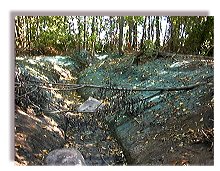Seeding for
Stability
By Damien Barstead
Have you ever been driving down a newly constructed highway, and wondered why
that fluorescent green was covering the surrounding banks and hills?
Agencies such the Ministry of Highways spray a mixture of seeds, fertilizer and
water, commonly called "Hydro-Seed," on unstable banks and hills that may potentially erode in
order to establish vegetation on them. The roots from these fast growing plants are needed to
stabilize the loose dirt and prevent it from sliding onto, or out from under, the highway.
The Haig-Brown Kingfisher Creek Society has chosen to use hydro-seed in its
restoration project. The decision was made because of the need to establish some kind of
stabilizing vegetation on the new stream banks before the winter season arrives. As well, its
relatively low cost, and instant application makes it a good short-term solution.
|
The hydro-seed application is being performed by Coastal Hydro-Seeding. The
hydro-seed they will use contains four main plant species: rye, a tufted grass, white fireweed,
and lupins.

In the background, notice the green colour
on the
stream banks. A mixture of seeds and
water is sprayed to help establish some
fast
growing vegetation, which will add
stability to the banks.
Although this mix itself will not serve as an adequate permanent ground cover, it may allow
other native plant species to establish themselves in some stable soil this fall or spring, as well as
suiting the projectís short term needs.
Future re-vegetation plans are also underway to provide the new stream with some
added cover and stability. Between the hydro seeding and other re-vegetation methods, the new
branch of the Haig-Brown Kingfisher Creek ought to look like a natural stream course in no
more than a few years.
Top of page.
|

